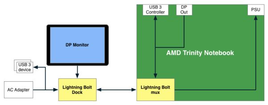Friday, January 13th 2012

AMD Lightning Bolt is USB 3.0 Over DisplayPort
AMD's competitive technology to Intel Thunderbolt, called "Lightning Bolt" (codename, marketing name may differ), surfaced at CES, where AMD was showing off its upcoming "Trinity" accelerated processing units. The technology was dissected by Anandtech, revealing exactly how AMD plans to achieve its goal of providing a much lower-cost alternative to Thunderbolt, over a similar-looking interface. While Thunderbolt is essentially PCI-Express x4 over DisplayPort, Lightning Bolt is the much more mature USB 3.0 SuperSpeed over DisplayPort. It is a single cable that combines a USB 3.0 with DisplayPort (display), and power (sourced directly from the PSU).
The part that makes it affordable is that AMD has already mastered GPU technologies that allow several displays connected to its GPUs using DisplayPort daisy-chaining; while USB 3.0 controllers are getting cheaper by the quarter. Connections of DisplayPort, USB 3.0 and power converge at a Lightning Bolt multiplex, from which the actual ports emerge. Lightning Bolt will stick to established mini-DisplayPort specifications.AMD has a lot invested in the success of its next-generation mobile platform based on its "Trinity" accelerated processing unit, and has no plans to help Intel propagate Thunderbolt on its mobile platform. The "Trinity" APU combines next-generation "Piledriver" x86-64 computing modules with a powerful Radeon HD 7000 series embedded graphics core, which takes advantage of AMD's Graphics CoreNext architecture, supporting DirectX 11.1.
Source:
Anandtech
The part that makes it affordable is that AMD has already mastered GPU technologies that allow several displays connected to its GPUs using DisplayPort daisy-chaining; while USB 3.0 controllers are getting cheaper by the quarter. Connections of DisplayPort, USB 3.0 and power converge at a Lightning Bolt multiplex, from which the actual ports emerge. Lightning Bolt will stick to established mini-DisplayPort specifications.AMD has a lot invested in the success of its next-generation mobile platform based on its "Trinity" accelerated processing unit, and has no plans to help Intel propagate Thunderbolt on its mobile platform. The "Trinity" APU combines next-generation "Piledriver" x86-64 computing modules with a powerful Radeon HD 7000 series embedded graphics core, which takes advantage of AMD's Graphics CoreNext architecture, supporting DirectX 11.1.

39 Comments on AMD Lightning Bolt is USB 3.0 Over DisplayPort
Intel/Apple Thunderbolt Codename "Light Peak": PCI-E 2.0 x4 + DisplayPort combined to make a high speed, versatile interface for all your peripherals. Devices are daisy chained and any device in the chain can access another. Peak bitrate is currently 10 GB/s. However, it's really only used for displays right now, which makes no sense as it takes up lanes on the PCI-E bus and we already have outputs from video cards themselves. Cables are active and cost $40-50...not exactly Intel or Apple's smartest ideas, however Apple can market even a turd to consumers. I usually call their MacBooks "polished turds".
AMD Lightning Bolt (they should watch they don't get sued for the name): USB3.0 + DisplayPort + Power over Lightning Bolt combined to make a high speed, versatile interface for all your peripherals. Devices are daisy chained. Peak bitrate is 5 GB/s (USB 3.0 standard). It does what Thunderbolt does and provides power however peak rate is 2-4x slower.
SSD's can barely saturate 5GB/s right now, why people are whining about peak speed I'm not sure. Half of us don't even have internet a fifth the speed of the rest of the world. Most I can buy here is 15/1 MB/s @ $65 a month while in other countries 50/20 MB/s can be had for 35 euro. I choose to complain about what's more important.
There is a reason why I come here for news and reviews.
Apple has an advantage here because they can integrate Thunderbolt on all their machines and you get it whether you want it or not (that assumes you're dumb enough to buy overpriced Apple shit in the first place). Whereas notebooks, and particularly motherboard, manufacturers have to decide whether adding $50 (or whatever the Thunderbolt implementation cost is) to the price of their hardware will make for something the consumer wants to buy, or will simply put their product in a price range no consumer will pay for.
For example, if you can buy a motherboard for $299, or you can buy one for $349, and the only difference between them is that the latter one has Thunderbolt... which one are you gonna buy? If you don't need Thunderbolt - and most people won't - you'll go for the $299 board.
Simple economics.
Biased sites are biased.:shadedshu
While Thunderbolt is definitely a niche product with few mainstream uses, Lightning Bolt is nothing but a kludge.